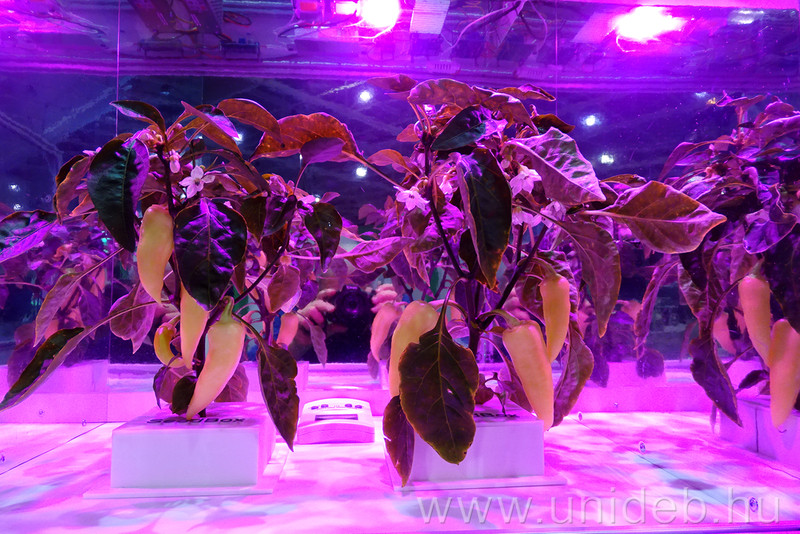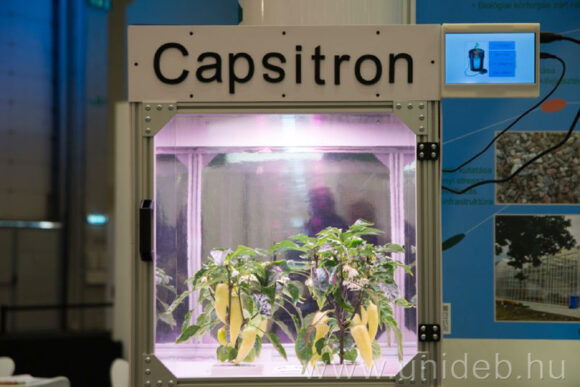The peppers of the University of Debrecen were harvested in a special space capsule, Capsitron, placed at the 20 Dreamers’ Exhibitions. In the UD SPACE research program, succulent and crunchy vegetables were grown in a special, closed technology system. In the project, UD experts will study several varieties of peppers. The goal is to produce the most crops in the smallest area with zero emissions. In early March, NASA’s pepper seedlings were planted in UD experimental greenhouse, Biodrome. In addition to the American NuMex Espanola Improved variety, the experts also started examining the Hungarian Enigma Sweet (HES), a pepper bred by the university.
In the experimental greenhouse of UD, the pepper varieties are tested under special conditions. The interesting thing about HES is that it has a genetically determined growth, so no human intervention, ie green pruning, is necessary during its upbringing. Examination of the green foliage of the HES revealed that its biomass is suitable for human consumption and contains a number of valuable bioactive substances. The taste of the leaves most closely resembles that of arugula
– Miklós Fári, a professor at the Institute of Plant Science, Faculty of Agriculture, Food Science and Environmental Management (MÉK), University of Debrecen, told hirek.unideb.hu.
The head of the UD Closed-Circuit Crop Research Group added that the American variety had already traveled into space after preliminary experiments by NASA. However, Espanola is an ever-growing type, its volume utilization efficiency is not ideal. It must be pruned in a confined space, during which the flowers are also removed by professionals, which reduces the amount of fruit.
Comparative analyzes are performed in Biodrome and Capsitron. In the latter place, the Espanola variety had to be pruned twice because it had grown out of the “cabin”. In the case of the HES variety, on the other hand, this was not necessary, because under limited conditions we do not spend the energy of production on the growth of stems and leaves, we do not produce unnecessary green waste, but we multiply the crop
– Miklós Fári added.
Experiments with Hydrospace peppers, one of the most important elements of space plant research in the DE-SPACE program, are also being carried out in the experimental greenhouse of MÉK. A young Hungarian biotechnology start-up company, jFermi Kft, is involved in the technical design and implementation of Capsitron.
The seeds were planted in so-called seedboxes, made in a 3D printer, in a special soil mixture that partially mimicked the lunar rock, which germinated in 10 days. In the irrigation vessel, a mixture of deionized water and a special nutrient solution circulates continuously, which is delivered to the plants through so-called water wicked. The process is fully automated. The closed system is only purified by biological methods. The recirculation ecosystem is implemented in the Biodrome of the UD Faculty of Agriculture, Food Science, and Environmental Management, so the production of plant raw material takes place from the cell to the final product, without by-products and waste, in an environmentally friendly way.
– added the university professor of the Institute of Botany of MÉK.
Miklós Fári emphasized that the legacy of Albert Szent-Györgyi is still alive today and determines the Hungarian pepper science, which is still at the forefront of the world. According to the plans of UD MÉK, the results of the practice will be transferable by the beginning of 2023. The relevant know-how and research knowledge was deposited with the Department of Technology Utilization.
debreceninap.hu / hirek.unideb.hu
Photo: unideb.hu



















